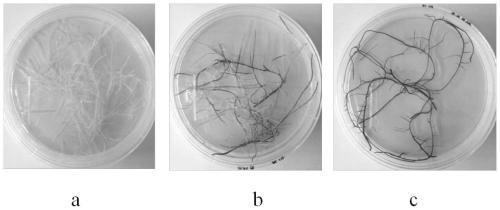Gene cloning, vector construction and application of baical skullcap root anthocyanin transcriptional regulation factors SbMYB75 and SbDEL
A technology of transcriptional regulatory factors and anthocyanins, which is applied in the fields of application, genetic engineering, plant gene improvement, etc., can solve many problems and achieve the effect of increasing anthocyanin production
- Summary
- Abstract
- Description
- Claims
- Application Information
AI Technical Summary
Problems solved by technology
Method used
Image
Examples
Embodiment 1
[0057] This example is the cloning of SbMYB75 and the construction of the corresponding plant expression vector.
[0058] (1) Design and synthesis of SbMYB75 gene primers
[0059] Firstly, the transcriptome of Scutellaria baicalensis was deeply sequenced, and then the protein sequence of PAP1 gene of Arabidopsis thaliana was compared in the Scutellaria baicalensis transcriptome database, using the related sequences of related species reported in Arabidopsis and Labiatae plants as the standard, Part of the sequence of coding protein similarity > 60% was selected to obtain the relevant gene sequence in Scutellaria baicalensis, primer premier 5.0 was used to design the full-length primers, and Gateway recombination sites were added to the primers (Gateway recombination sites are underlined).
[0060] SbMYB75-F: GGGGACAAGTTTGTACAAAAAAGCAGGCTTC ATGGAAAAGAAAGGTGAAGTAAAGAG (SEQ ID No. 5);
[0061] SbMYB75-R: GGGGACCACTTTGTACAAGAAAGCTGGGTT TTAACTCGAATAGGGACCTATGAG (SEQ ID No. 6);...
Embodiment 2
[0077] This example is the cloning of SbDEL and the construction of a binary plant expression vector containing both SbMYB75 and SbDEL.
[0078] (1) Design and synthesis of primers for SbDEL gene and CaMV35S promoter
[0079] Firstly, the transcriptome of Scutellaria baicalensis was deeply sequenced, and then the protein sequence of the DEL gene of Snapdragon was compared in the Scutellaria baicalensis transcriptome database, and the related sequences of related species reported in Arabidopsis and Labiatae plants were used as the standard to select Sequences with a partial coding protein similarity >60% were obtained to obtain related gene sequences in Scutellaria baicalensis, and primers were designed using primerpremier5.0 to design full-length primers, and the end sequence of the CaMV35S promoter was introduced before the upstream primer of SbDEL, and RsrII was introduced before the downstream primer Restriction sites and protective bases.
[0080] Using pK7WG2R as a templ...
Embodiment 3
[0108] In this example, a transgenic cell line containing SbMYB75, SbMYB75 and SbDEL was obtained by using the exogenous plant carrot.
[0109] Using the electric shock method, the plant expression vectors pK7WG2R-SbMYB75 and pK7WG2R-SbMYB75-SbDEL were transformed into A. rhizogenes A4 to obtain the expression vector containing SbMYB75 and the A. rhizogenes containing the binary expression vector of SbMYB75 and SbDEL respectively. At the same time, the empty plasmid containing the CaMV 35S promoter was transferred into the strain as a negative control.
[0110] Carrot seeds were routinely sterilized on the surface, placed in MS medium, and cultured under light at 25°C. After 30 days of cultivation, sterile carrot tissue culture seedlings can be obtained. Carrots were transformed by infecting leaf veins, and the infected leaves were placed on MS solid medium containing 50mM acetosyringone (AS), cultured in the dark at 25°C for 48-72h, and then transferred to medium containing ...
PUM
 Login to View More
Login to View More Abstract
Description
Claims
Application Information
 Login to View More
Login to View More - R&D
- Intellectual Property
- Life Sciences
- Materials
- Tech Scout
- Unparalleled Data Quality
- Higher Quality Content
- 60% Fewer Hallucinations
Browse by: Latest US Patents, China's latest patents, Technical Efficacy Thesaurus, Application Domain, Technology Topic, Popular Technical Reports.
© 2025 PatSnap. All rights reserved.Legal|Privacy policy|Modern Slavery Act Transparency Statement|Sitemap|About US| Contact US: help@patsnap.com



